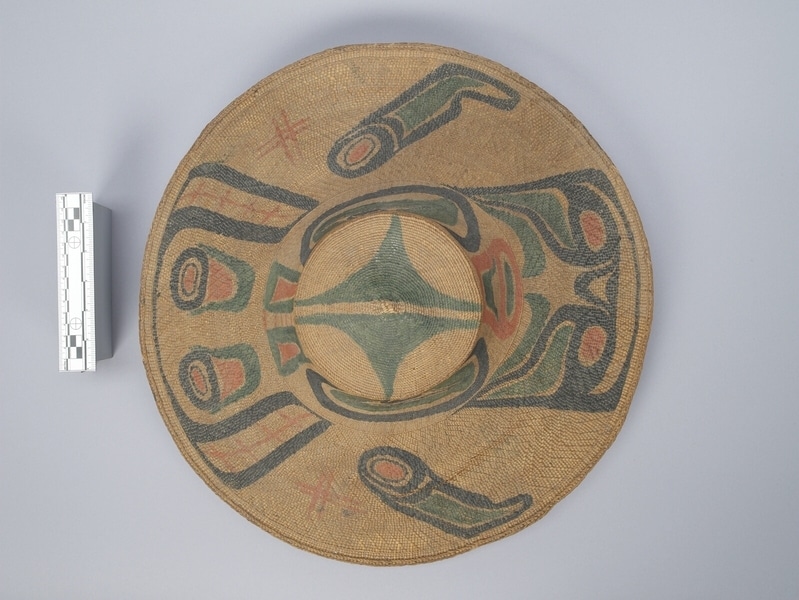Hat Item Number: Nb3.1414 from the MOA: University of British Columbia



Description
Wide brimmed hat with sloping sides and slightly convex across top of crown. Rim has two raised rows of three strand twining. Brim is z-twist plain twining with twill twined zigzag pattern. Crown and top are three strand(?) z-twist twined. Attached inner head band is two strand z-twist. Freely painted design is generally bilaterally symmetrical with a green four pointed star on top with central unpainted channel. Large green ovoid eye on either side of crown, black outlined with round black centre and tapering outline. On crown are green, small b and d shapes surrounding red u-shapes with horizontal red lines between. On front, of crown, is red u with green ovoid at bottom and green u interior. On brim, at front, is a face in square-like black outlined ovoid with wide mouth, red ovoid eyes, green l-shapes above black outlined eyes, and green u-shapes at top. Diagonal limb-like form on sides, with ovoid in ovoid start and bent u to outside with green interior. Red double cross before u-shaped tail section with two black curving lines on sides with central red line crossed by horizontal red lines. Ovoid in ovoids on each side of centre with red and green u's above.
History Of Use
Hats of this style were traditionally worn only by high status individuals. This style of painted basketry hat was probably adopted from the Haida, about 1860. It is also possible that, at least some, unpainted hats were acquired by the Kwakwaka'wakw and painted with their distinctive designs.
Iconographic Meaning
The iconography may depict a sea monster.
Narrative
Said to have been gifted to General Chapman of the British Royal Marines c. 1900, at a potlatch in Victoria. His son, Major George Arthur Emerson Chapman is said to have brought the hat with him to Ottawa c. 1924; he then gifted it to Andrew and Mary Hazeland in the 1960s, who brought it back to Victoria.
Item History
- Made in British Columbia, Canada during 1900
- Collected during 1900
- Owned by George Arthur Emerson Chapman
- Owned by Mary Hazeland before March 25, 1983
- Owned by Mr. Chapman during 1900
- Owned by Andrew Hazeland during 1965
- Received from Mary Hazeland (Seller) and Museum of Anthropology Shop Volunteers (Funding source) on March 25, 1983
What
- Name
- Hat
- Identification Number
- Nb3.1414
- Type of Item
- hat
- Material
- paint and spruce root
- Manufacturing Technique
- twined, twill twined and painted
- Overall
- height 19.0 cm, width 47.0 cm
Who
- Culture
- Kwakwaka'wakw
- Previous Owner
- George Arthur Emerson Chapman, Mary Hazeland, Mr. Chapman and Andrew Hazeland
- Received from
- Mary Hazeland (Seller) and Museum of Anthropology Shop Volunteers (Funding source)
Where
- Holding Institution
- MOA: University of British Columbia
- Made in
- British Columbia, Canada
When
- Creation Date
- during 1900
- Collection Date
- during 1900
- Ownership Date
- before March 25, 1983, during 1900, and during 1965
- Acquisition Date
- on March 25, 1983
Other
- Item Classes
- basketry
- Condition
- fair
- Current Location
- Case 18
- Accession Number
- 0903/0001